PLAISTOW, E 13.
| The first recorded use of the name Plaistow was in 1414. The area was also known as Sudbury because it was the Southern manor of Ham. The name Plaistow can be understood if we think of it as Plais town. For a tow or stow was Old English meaning a fenced off place, and Hugh de Plaiz owned this manor in late Norman times. (A similar occurrence of this in East London is in Walthamstow). Plaistow was on the edge of solid ground bordering one the marshes beside the Thames. The marshes provided rich agricultural ground. A prize ox which had grazed on One Tun Marsh near Plaistow was sold at Leadenhall market in 1720, which was said to be exceptionally heavy. |
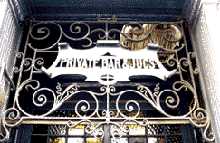 |
The Abbey Arms. |
|
On the corner of New Barn Street and Barking Road. This wrought iron sign saying PRIVATE BAR & JUGS is over the entrance of the Abbey Arms in New Barn Street. Some customers brought their own jugs to be filled and taken away. This was a common practice for women who did not want to drink in the bar to take away a jug of beer and drink it at home, particularly as it was cheaper when sold by the jug. This pub was rebuilt in 1882. The name of the pub derives from the fact that Stratford Longthorne Abbey once owned much of the land in the area. (See No. 1. on the MAP ) |
||
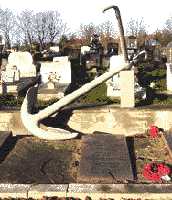 |
HMS Albion Disaster. |
|
At the end of a long avenue, facing you as you enter the main gate of East London Cemetery, Grange Road. This monument marks the grave of 28 of the 38 victims who died in June 1898, when HMS Albion was launched from the Thames Iron works shipyards at Bow Creek. A vast crowd came to witness the launching of the cruiser by the Duke and Duchess of York (later king George V and Queen Mary). 200 of the onlookers crowded onto a flimsy wooden walkway to get a better view. When the ship was launched, it caused a large wave which washed away the supports of the walkway and threw all 200 into the ten-foot deep water amidst the debris. Rescuers saved about 160, but the rest drowned. While visiting this cemetery, look out for some of the specially designed gravestones. Visible from this avenue are a dartboard, some horses' heads and a stone depicting football equipment. (See No. 2. on the MAP ) |
||
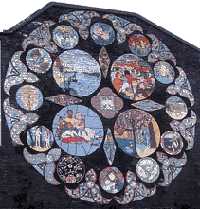 |
Balaam Street Mural. |
|
On the side of no. 40 Balaam Street. Painted by Newham Community Murals '83. The artists involved were: Catherine Baker, Julie Allen, Richard Lilley, S. Kane, M. B. Allen and A. Di Stefano. Balaam Street was mentioned c. 1360 and was named after Hugh de Balun who owned property in the Plaistow area c. 1180. (See No. 3. on the MAP ) |
||
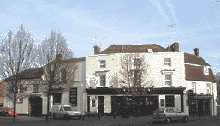  |
The Black Lion. |
|
On the corner of the High Street and Richmond Street. This pub dates back at least to the early 1700s. It has been much altered over the ages, but the square doorway to the left of the left hand picture was built to enable horse-drawn carriages to enter into the cobbled courtyard. In 1809 the Pub was mentioned in a court case at Chelmsford Assizes. On Whit Monday of that year, a public holiday, there were plans to run races from the Greyhound to the Black Lion and also to have various games. Some of the more serious minded inhabitants of the village, fearing that this was an attempt to restart a previously banned annual fair held opposite the Greengate Pub, published notices saying that the races were illegal. On the day, about 200 people turned up and several magistrates and constables attempted to stop the fun. The result was a fracas which lasted all afternoon and several people were charged with riot and conspiracy. The judge dismissed the charges saying that races did not constitute a riot. This presumably means that those arranging the Olympic races in Newham 2012 are not liable for prosecution on these counts. (See No. 4. on the MAP ) |
||
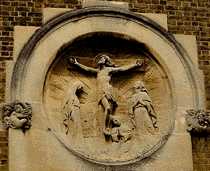 |
The Crucifixion. |
|
On the wall of St Philip's Church on the corner of Whitwell Road and Webb Gardens and visible from the latter street. (See No. 5. on the MAP ) |
||
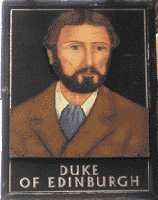 |
Duke of Edinburgh. |
|
Sign on the pub in Jutland Road on the corner of Frank Street. The painting shows no resemblance to the present Duke, as the pub was built in 1909 which was before he was born. This pub is probably named after Prince Albert (1844 – 1900). Who was the fourth child of Queen Victoria and who was given this title. (See No. 6. on the MAP ) |
||
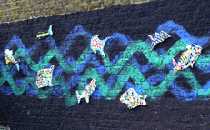 |
Fish Wall. |
|
Eleanor Smith School, North Street. On the boundary wall of the playground there is an aquatic mural made up of mosaic fish, fixed to brick wall which has been painted various shades of blue to symbolise flowing water. (See No. 7. on the MAP ) |
||
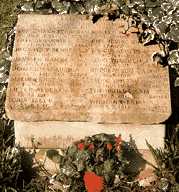 |
German Spies and Chinese Londoners. |
|
East London Cemetery, Grange Road. Down the main central path past to the two chapels to a T-junction where there is a large anchor ( No. 2 on the map) , the turn left after about 80 yards there is a bench. By the side of this is a stone with 16 names on it. All of these were men found guilty of spying for Germany in World War 1. They were imprisoned in the Tower and shot. This is an official German war grave. A little further along the same path there are a large number of stones with Chinese inscriptions. This a reminder of the many Chinese who have lived and worked in East London. (See No. 8. on the MAP ) |
||
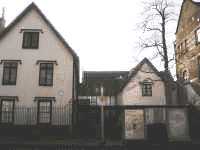 |
The Hidden House. |
|
In Greengate Street, just north of Plaistow Park is the Essex Lodge Surgery. This building has a secret behind the taller part of the building there is a two storey wooden Tudor building with an overhanging second floor which has been hidden by later exterior walls and none of it can be seen from the outside. This Tudor building was probably part of Essex House which was said to have belonged to the Duke of Somerset who was appointed Protector of the young King Edward VI. (See No. 9. on the MAP ) |
||
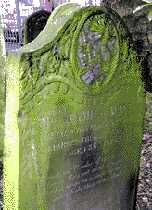 |
Landlord's Lament. |
|
In the green area, previously St Mary's churchyard. Enter from St Marys Road turn left just inside the gate The stone is almost at the boundary with the inscription facing away from you. The tombstone is of James Davis "of the Coach and Horses" who died in 1855. This pub still stands in Greengate Street, but (in 2007) is boarded up and has a For Sale board outside. The poem on the stone was not exactly chosen to provide good cheer. It reads: Boast not Reader of thy might:The design on the stone which includes bunches of grapes may have been chosen because he was a publican. (See No. 10. on the MAP ) |
||
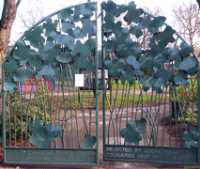 |
Lister Gardens Gates. |
|
Florence Road. Two pairs of gates specially designed for this small park. The gardens are named after Lord Lister (1827-1912) who introduced the first antiseptic procedures into hospitals. He therefore revolutionised modern surgery. Lister was born in Upton House which used to stand in Upton Lane, facing the present West Ham Park. These gardens compensate rather inadequately for the council's failure to stop Lister's house from being pulled down. (See No. 11. on the MAP ) Artist: Daksha Amin. |
||
 |
The Illiterate Pigeon. |
|
Notice on the pavement in Green Street in front of Queens Market. Beside the pigeons, other Newham residents ignore the notices by leaving crusts of bread. However this may not continue for much longer, for after 110 years of existence, there are now controversial plans to redevelop the area. The new "upmarket" market will still have the individual stalls and the shops, but will also include a library, at least one supermarket and a 31 storey tower block of apartments. Existing stall holders and their customers fear that the rents for pitches will be higher forcing up prices of goods, that the supermarket will provide unfair competition by bulk-buying and the use of uneconomic loss-leaders etc, and that the developers will be more interested in the tower block than the market. Read further on the scheme at: |
||
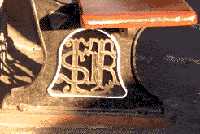 |
Plaistow Station. |
|
Plaistow Road. The station dates back to 1858. The ironwork on some of the seats is almost as old. The letters LTSR stand for the London Tilbury and Southend Railway which ran steam trains along this line until 1912, when it became the London Midland Railway There are some brackets supporting the roof over the platforms with a similar monogram. (See No. 13. on the MAP ) |
||
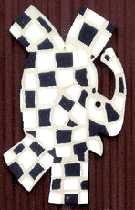 |
Ravenscroft Mural. |
|
One of several artworks on the exterior walls of Ravenscroft Primary School which is on the corner of Jutland Street and Avenons Road. It can be seen from the latter road. (See No. 14. on the MAP ) Artist: Elmer Nursery. 2005 |
||
 |
St Andrew. |
|
St Andrew's Church, Barking Road. The figure is over the west door of the church. If this is St Andrew then he was a fisherman who was one of the twelve apostles and the brother of St Peter. He travelled around preaching and was crucified in Greece. He is the patron saint of Greece, Russia and Scotland. Behind the figure is the St Andrews cross that he was said to have died on. (See No. 15. on the MAP ) |
||
 |
Sculpture. |
|
In front of the Southern Road Primary School. This large abstract metal sculpture, surrounded by a fence, stands in front of the building. It is visible from Southern Road through gaps in the border hedge. (See No. 16. on the MAP ) |
||
 |
Selwyn Junior School Mural. |
|
At the end of Selwyn Rd. One of three painted panels used to brighten the children's lives. (See No. 17. on the MAP ) |
||
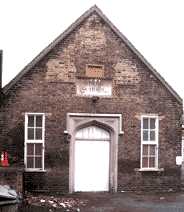 |
The Old School House. |
|
On the corner of St Marys Road and May Road. This small building has written on it GIRLS SCHOOL and the date of 1836. Although it was the custom to educate boys and girls separately, at least one school in Plaistow had mixed classes in the 19th century. One of the ministers associated with this school was John Curwen who developed the Tonic Sol-fa method of teaching singing. (See No. 18. on the MAP ) |
||
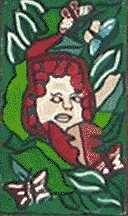 |
Southern Road School Murals. |
|
One of the mural panels on the Southern Road Primary School which are visible from the footpath between Eastern Road and Western Road. There are more panels and a sculpture on the front of the building. Note the illogical system of naming streets used here. If you walk along this path from west to east, you will be going from Eastern Road to Western Road. (See No. 19. on the MAP ) |
||
 |
The Lord Stanley |
|
The pub on the corner of Plaistow Park Road and St Marys Road. The noble Lord is depicted wearing a top hat, sporting a monocle and holding a glass of wine. The peerage of the Stanley family goes back at least to the reign of Richard III. It is probably named after Edward Lyulph Stanley (1839-1925) who became Lord Stanley of Alderley and who was an MP and also leader of the Progressive Party on the London School Board and officiated at some of the functions at local schools. One of his Stanley ancestors became Earl of Derby in 1780, and instituted the horse race which is still called the Derby. (See No. 20. on the MAP ) |
||
 |
Tolgate Mosaic |
|
On the wall of Tolgate Primary school in Barclay Road. The mosaic is accompanied by brightly coloured shapes which helps to brighten an area which is otherwise without works of art. (See No. 21. on the MAP ) |
||
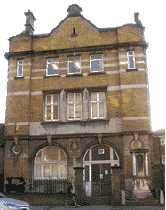 |
West Ham Tramways Offices. |
|
Greengate Street. Electicity powered trams began running from Plaistow in 1904 and these offices were built in 1906. In front of the building there is a monument commemorating about 50 of their employees who "fell in the European War 1914 – 1919".(See No. 22. on the MAP ) |
||
OTHER AREAS COVERED:-
|| Beckton || Bethnal Green || Blackwall || Bow || Bromley-by-Bow || Canary Wharf || Canning Town || Chingford || Cubit Town || Custom House || East Ham || East India Dock || Forest Gate || Higham's Park || Leyton || Leytonstone || Limehouse || Little Ilford || Manor Park || Mile End || Millwall || North Woolwich || Plashet || Poplar || St George's || St Katharine Dock || Shadwell || Shoreditch || Silvertown || Snaresbrook || Spitalfields || Stepney || Stratford || Upton || Walthamstow East || Walthamstow Village || Walthamstow West || Wanstead || Wapping || West India Dock || Whitechapel || Woodford || |
 TO READ NAME ~ CLICK FOR PHOTO & EXPLANATION.
TO READ NAME ~ CLICK FOR PHOTO & EXPLANATION.